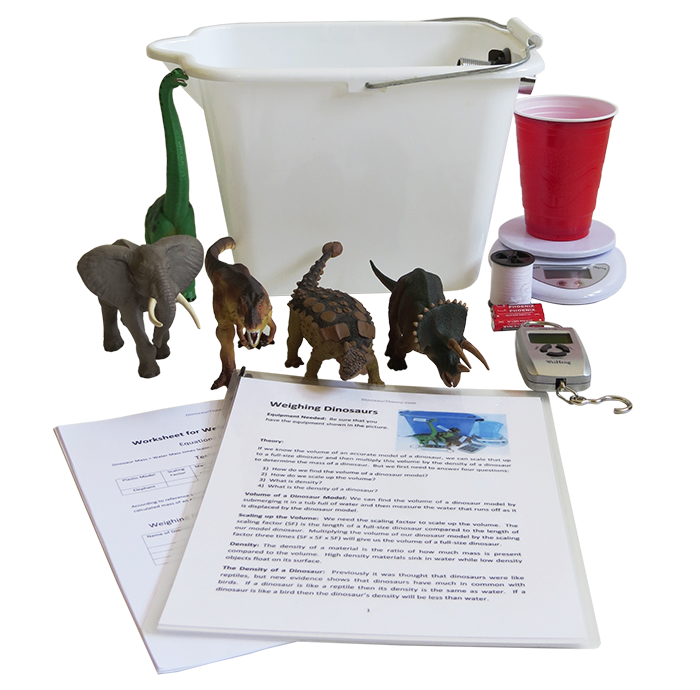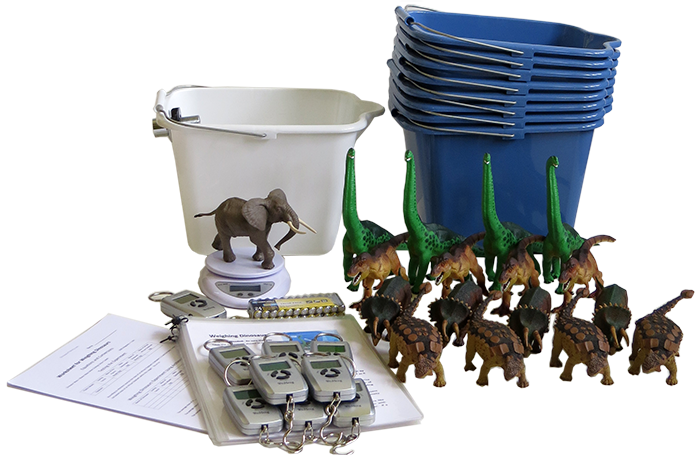Weighing Dinosaurs
Introduction:
How can a scientist determine the mass of a dinosaur when the last of these animals were alive over sixty five million years ago? Actually it is not difficult at all if we have accurate models of dinosaurs and some simple equipment.
Equipment Needed:
- Solid plastic models of dinosaurs
- Water bucket with side overflow spout
- Table Scale
- Hanging Scale
- Cups
- Dishwashing soap
- String
- Calculator
Theory:
If we know 1) the scaling factor between the dinosaur model and an actual dinosaur, 2) the volume of the dinosaur model, and 3) the density of a dinosaur then we can calculate the mass of an actual dinosaur. Dividing known dimensions of dinosaurs by the same dimension of our model will give us the scaling factor. Measuring how much water is displaced when we submerge our dinosaur in water will give us the mass of the displaced water that we need for our calculations. Finally even though we can not directly measure the density of dinosaurs since they are extinct, we can still compare these extinct vertebrates to present vertebrates and conclude that the density of a dinosaur is at or close to 1.0 g / cm3.
Density is a measurement of how much mass is contained per unit volume (D = M / V). Most metals have high densities while foam materials used for packing boxes for shipment have very low density. A solid high density object will sink when placed in the water while a low density object will float. One gram per centimeter cube is the density of water.
Density is a measurement of how much mass is contained per unit volume (D = M / V). Most metals have high densities while foam materials used for packing boxes for shipment have very low density. A solid high density object will sink when placed in the water while a low density object will float. One gram per centimeter cube is the density of water.
Because the mass of a dinosaur is the same as the mass of the water that it displaces, we can calculate the mass of an actual dinosaur by measuring the mass of
water that a model dinosaur displaces and then use our scaling factor to determine the mass of an actual dinosaur.
Procedure:
- Place your water bucket on a steady table with a cup under the waterspout to catch the water.
- To reduce the water's surface tension, add a couple drops of dishwater soap to the water. It also helps to spread a thin layer of dishwater soap in the inside of the waterspout
- Slightly overfill the bucket of water then let it drain for five minutes. Set the mode of the scale to grams.
- Tie a string around your dinosaur model
- Trade the overflow cup for a empty cup then hold the string as you slowly lower the dinosaur model to rest at the bottom of the bucket.
- Wait five minutes before weighing the displaced water.
- Subtract the mass of an identical empty cup from the mass of cup fill with the displaced water to get the mass of the displaced water.
- Tie a string around the middle of your dinosaur then tie the other end of your string in a loop so that you can hang your dinosaur by the hanging scale.
- Tare your scale to zero while there is no tension on the string then lift your scale so that the plastic model hangs in the air. Record the mass of the plastic model.
- Submerge your model in the bucket of water. Allow the model to rest on the bottom of the bucket and tare your scale to zero. Lift your scale so that the model is off the bottom but still submerged. Record the mass of the submerged model.
- Subtract the mass of the submerged model from the mass of the plastic model. Record this as the mass of the displaced water.
Multiply the mass of the displaced water by your scaling factor cubed and then enter this answer in the column marked Mass of Dinosaur.
Repeat this procedure for each of your dinosaurs.
While the run-off method is not without its merits, students enjoy weighing their dinosaurs using Archimedes' Principle because they get good result, and it is fast and easy to do. It is for these reasons that the Archimedes' Principle method is the method used by the Weighing Dinosaurs Experiment sold in the DinosaurTheory store.
Science Educator's Demonstration using Archimedes' Principle:
| Example | Scaling Factor | Mass of Plastic Model (kg) |
Mass of Submerged Model (kg) |
Mass of Displaced Water (kg) |
Mass of Elephant (kg) |
|---|---|---|---|---|---|
| African Elephant |
30 | 0.275 | 0.070 | 0.205 | 5,500 |
The elephant model is included in the experiment to demonstrate to students that the experiment procedure gives the correct mass of this large terrestrial animal and so logically, it should work for determining the mass of dinosaurs.
Student Worksheet using Archimedes' Principle:
| Name of Dinosaur | Scaling Factor | Mass of Plastic Model (kg) |
Mass of Submerged Model (kg) |
Mass of Displaced Water (kg) |
Mass of Dinosaur (kg) |
|---|---|---|---|---|---|
| Ankylosaurus | . | . | . | . | . |
| T-Rex | . | . | . | . | . |
| Triceratops | . | . | . | . | . |
| Brachiosaurus | . | . | . | . | . |
Helpful Equations:
Scaling Factor equals length of actual dinosaur divided by the length of the model.
S.F. = Ld / Lm
Volume of dinosaur equals volume of dinosaur model times the scaling factor cubed.
Vd = Vm x (S.F.)3
Volume is equal to the mass divided by density.
V = M / D
(Md / Dd) = (Mw / Dw) x (S.F.)3
Density of a dinosaur is extremely close to being equal to the density of water.
Dd = Dw
Therefore the mass of the dinosaur equals the mass of displaced water times the scaling factor cubed.
Md = Mw x (S.F.)3

